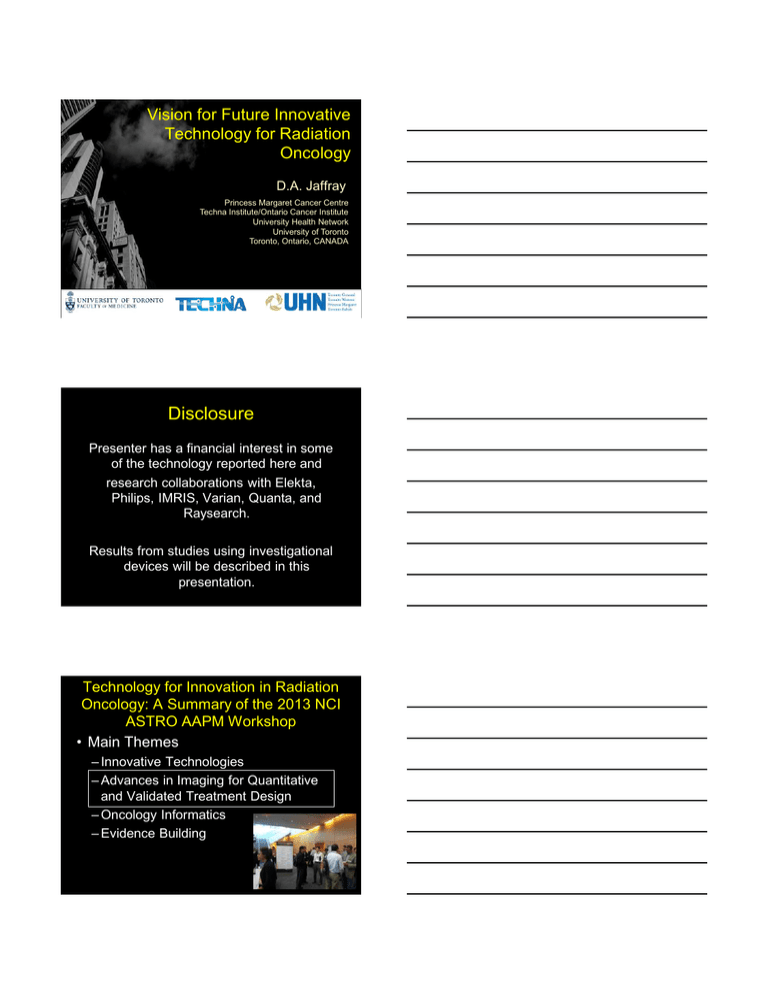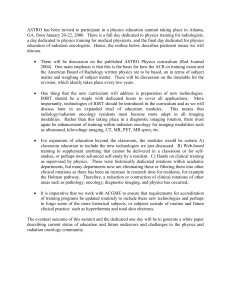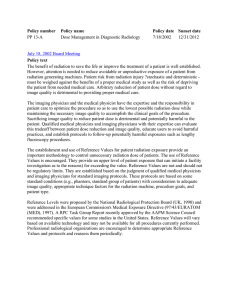Vision for Future Innovative Technology for Radiation Oncology
advertisement

Vision for Future Innovative Technology for Radiation Oncology D.A. Jaffray Princess Margaret Cancer Centre Techna Institute/Ontario Cancer Institute University Health Network University of Toronto Toronto, Ontario, CANADA ASTRO-AAPM-NIH’13 Disclosure Presenter has a financial interest in some of the technology reported here and research collaborations with Elekta, Philips, IMRIS, Varian, Quanta, and Raysearch. Results from studies using investigational devices will be described in this presentation. Technology for Innovation in Radiation Oncology: A Summary of the 2013 NCI ASTRO AAPM Workshop • Main Themes – Innovative Technologies – Advances in Imaging for Quantitative and Validated Treatment Design – Oncology Informatics – Evidence Building 1 Capacity to Integrate Molecular/Functional Imaging in RT is Significant Database of Dose Targets and Tolerances Calc’n CT Contouring ; Optimization CT/PET MR IMRT Beam Patterns Geometry Change d Specific Patient Biology Change IGRT Adjustments RT needs robust information about the extent of disease. Daisne et al Radiology 94 (2004) Need to engage pathology more in target characterization. Too few investigators working on this problem. Caution: Is someone hiding delineation uncertainties in the PTV margin? PTV 2 From Anatomical to Functional • Classical Dosimetric Objective: – Deliver a uniform dose to the ‘clinical target’ – Minimize or limit the dose to surrounding normal structures The development of image-guidance technologies addresses the geometric challenges and enables pursuit of functional or molecular sub-targets. • Biological Objective: But what is a valid biological target? - Maximize therapeutic ratio Conceptual Framework for Integration of Functional/Molecular Imaging “Incremental to the concept of gross, clinical, and planning target volumes (GTV, CTV, and PTV), we propose the concept of “biological target volume” (BTV) and hypothesize that BTV can be derived from biological images and that their use may incrementally improve target delineation and dose delivery.” - Ling et al. Ling et al., Int. J. Radiation Oncology Biol. Phys., Vol. 47, No. 3, pp. 551–560, 2000 From the ‘3D Hypothesis’ to the ‘BTV and 4D Hypotheses’ • BTV Hypothesis: Patterning radiation dose according to imaged functional or molecular distributions will increase the TR. – A.k.a. ‘Biologically Targeted Radiation Therapy’ • 4D Hypothesis: Adapting to imaged changes in geometry or function during RT will improve the therapeutic ratio. – A.k.a. ‘Adaptive Radiation Therapy’ 3 Functional and Molecular Imaging for RT • Tumour burden, altered metabolism, and clonogen density (e.g. FDG, MRS) • Tumour hypoxia (e.g. F-MISO, I/FAZA, CAIX, MRBOLD, HX4) • Tumour proliferation (e.g. FLT) • New imaging targets (e.g. FACBC amino acid, EGFR for re-population) • Functional imaging of crucial healthy tissues (e.g. SPECT/CT/MR derived lung perfusion) • Vascular and physiological measures (DCE-MR/CT, MR DWI/ADC) Adapted From ‘Theragnostic imaging for radiation oncology: dose-painting by numbers’ - S.M. Bentzen - Lancet Oncol 2005; 6: 112–17 Impact of Specific and Sensitive Imaging of Disease on Radiation Therapy 1. Reduce observer-dependent variation in the extent of gross and clinical targets. 2. Enable biologically-modulated targeting of the radiation dose. 3. Enable prediction of response based upon pre- or intra-treatment changes in the image-based biomarkers. See Steenbakers 2006, Bentzen 2005, Mayr 2010 Conceptually simple, but execution has been very slow... • There are signs of progress: – MRI. Dominant lesion in multi-focal disease (e.g. DCE/DWI/BOLD definition of dominant lesion in prostate cancer – correlation with pathology) – FDG-PET. Targeting regions of elevated metabolism as characterized by FDG-PET – Hypoxia. Targeting regions of hypoxia as characterized by F-MISO/FAZA/ATSM agents • Challenges: – Validation of image signal, cost of imaging/ pathology correlation, prescription/radiobiology, technical (segmentation, robust imaging, motion compensation, non-specific signal e.g. bladder) 4 Effect of Ignoring 4D in FDG-PET for the Lung From the ‘3D Hypothesis’ to the ‘BTV and 4D Hypotheses’ • BTV Hypothesis: Patterning radiation dose according to imaged functional or molecular distributions will increase the TR. – A.k.a. ‘Biologically Targeted Radiation Therapy’ • 4D Hypothesis: Adapting to imaged changes in geometry or function during RT will improve the therapeutic ratio. – A.k.a. ‘Adaptive Radiation Therapy’ Computational Advances Needed for Testing the ‘4D’ Hypothesis Autosegmentation Deformable Registration Dose Tracking Replanning Time-based data architecture for adaptive and response studies. 5 Many scientific questions in the domain of biologically-guided RT. • What treatment targets are optimal for different tumor histologies and genotypes? • How to translate from radiobiological heterogeneity to dose heterogeneity? • What biological changes occur in tumor and normal tissue during therapy and how do we adapt RT to those changes? • How often do we need to adapt the plans? • What other biomarkers beyond and in combination with imaging do we need? • How to integrate radiation therapy with other treatment modalities to increase efficacy? How do we integrate all these RT and other biomarkers? Technology for Innovation in Radiation Oncology: A Summary of the 2013 NCI ASTRO AAPM Workshop • Major undertones – Need disruptive technologies in RO – Need technical, quality, and safety performance of these technologies – Need process automation and oncology informatics A balance between disruptive technologies and the need for evidence of efficacy and effectiveness Medical Physicists are capable of inventing, developing, and deploying technology in the clinical setting. We benefit from a rich array of technology development around us. 6 Next Gen RT Technologies: Enabled by Better Dose Deposition, Robotics, Computation, Imaging Edmonton Solution Utrecht Solution Protons+ PET-guided RT Viewray Solution Adjacent Solutions MR-Guided RT Better dose control, faster imaging, higher CNR, more responsive in delivery. Technological Innovation in RT • From Anatomic to Functional Targeting – Validation for Target Delineation – Anatomical and Response Adaptation • Nanotechnology (hot and cold) – Modification/Prediction of Response – Dosimetry of drug delivery • A New Breed of Multi-modal Machines – Fast Physics that ‘Bury the Complexity’ • Our Biggest Treatment Machine Yet – Standardization, Automation, Quality, Efficiency, and Evidence ASTRO-AAPM-NIH’13 7 An Apparent Conflict Radiation Oncology and Medical Physicists are known for creation and adoption of technology. vs Technology needs to be better evaluated. Radiation Oncology and Medical Physicists need to be bridled to assure we have evidence. An Apparent Conflict Opportunity Radiation Oncology and Medical Physicists are known for creation and adoption of technology. vs Technology needs to be better evaluated. Radiation Oncology and Medical Physicists need to turns their creativity to build evaluation into innovation. RT: A Highly Personalized Cancer Medicine 8 A Multi-modal Perspective Uni-modal biomarkers are not sufficient for informing clinical decisions and the full power of genomics will be only be fully unleashed through integration with multi-modal datasets. Hypoxia, Receptor, Permeability Genetic/Proteomic/ Receptor H&N Image-based Biomarkers Tissue-derived Biomarkers OS<- HPV,p16: 20% (Shi 2009), DFS<-FAZA-PET: 33% (Mortensen 2012) LRC<-RT Compliance: 20% (Peters 2012) Intervention Prostate bPSA<IGRT: 25% (deCrevosier 2005), bPSA<pO2: 25% (Milosevic 2012), bPSA<Metformin: 10% (Zannella) Performance Outcome Measures RT, Sx, Cx IGRT, IGS, IGDD Clinician, Patient Reported NSCLC . LC<-FDG-PET Response: 40% (DeRuyescher, 2012) OS<-CT Feature: 10% (Aerts 2013) OS<-RT Technique: 25% (Liao, 2010) RadPneum<-Cardiac Fn: 2.6 OR (Nalbantov, 2013;) 25 Personalized Cancer Medicine (PCM) ‘The right care for the right patient at the right time.’ Patients or practitioners? "If it were not for the great variability among individuals, medicine might as well be a science, not an art." Sir William Osler, 1892 Our Biggest Machine Yet. 9 Paradoxically, Getting Personal Requires Getting Industrial Hypoxia, Receptor, Permeability Genetic, Proteomic, Receptor Image-based Biomarkers Tissue-derived Biomarkers and ‘Omics Intervention Performance RT, Sx, Cx IGRT, IGS, IGDD All three factors characterized + outcome measures Understanding cancer, developing personalized cancer medicine strategies, and delivering high performance cancer therapy are highly dependent activities. ASTRO-AAPM-NIH’13 Medical Physics Efforts Toward ‘Industrial Medicine’ • Safety and Quality as Priorities – Variance Tracking, Measurement • Advancing a Nomenclature for RT – ICRU 50, 62, 83 • Standardization in Treatment Methods – Delineation Standards • Measuring Outcomes – Pay for Performance, Expertise Growth • Engineering Principles – FMEA, Control Charts, Measure and Correct Strategy 10 Getting Industrial • Standards and Nomenclature – Communication and Automation • Precision and Accuracy – in our Measurements – in our Treatment Delivery • Collaboration – Statistical Strength through Multi-institutional Studies • Informatics – Managing the known unknowns and watching for the unknown unknowns Are Quality and Innovation Competitive? ASQ (American Society for Quality) is the world’s leading authority on quality and sole administrator of the Malcolm Baldridge National Quality Award. ASQ 2010 Continuous Expertise/Knowledge Development – Contribute and Benefit Deasy et al. - Int J Radiat Oncol Biol Phys. 2010 March 1; 76 11 Converting on the Promise of Personalized Cancer Medicine • From delivering ‘state-of-the-art’ care to driving the next generation of care. – Radiation Oncology and Medical Physicists have always innovated practice, but this needs to be industrialized to accommodate the complexity of data collection, decision making, and delivery. • Maximizing intervention performance (quality) to detect sub-populations and evaluate the value of new, more personalized therapies • Building cancer informatics tools to enable analysis, exploration, and rapid evaluation of novel therapies or stratification. The Physicist’s Approach • When you want to answer a really big question… –you get lots of talented people engaged, –you distribute the work, –and you build a machine. CERN 3000 Scientists 174 Universities 38 Countries Working together on the border of France and Switzerland Could translational cancer research become another well-known large-scale science project? 12 Atlas Detector: Big Data Handling • • • • • • >80 million Si pixels >100,000 ionization ‘straws’ >100,000 calorimetry channels 25 ns resolution >350,000 particles/sec/mm2 40 million bunch crossings/sec Dedicated data system filters to 100,000/s (L1), 3000/s (L2), 200/s (L3 – for detailed analysis) ASTRO-AAPM-NIH’13 What would the ‘machine’ for seeking the limit of PCM look like? • It’s design would push the limits of our science – Drive new technologies and methods from basic science • It would need to be precise – Measurement/Terminology • It should be accurate – Standardized/Validated/Calibrated • It should be efficient – Affordable; large N; statistical power • Needs to be integrated with healthcare delivery Isn’t this this a remarkably good match for the skills in Radiation Oncology and Medical Physics? How would it work? • A steady stream of well-characterized patients colliding with a well-characterized set of interventions. • Surrounded by certified, calibrated beam control and detection instruments (controlled therapy, imaging, outcomes). • Data streaming into an appropriately staged real-time and off-line informatics framework. We just need to build it. 13 Summary • Numerous emerging technologies with the potential to impact Radiation Oncology • Include advances in imaging, nanotechnology, device development. • Personalized cancer medicine is an emerging medical, scientific, and technical challenge and medical physicists in radiation oncology have a significant role to play. • Advancing informatics as a central research pillar for the field is timely and appropriate. 14


